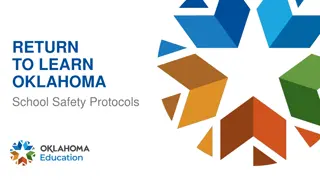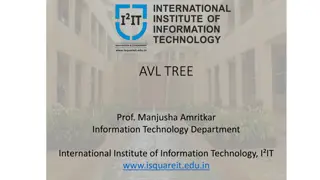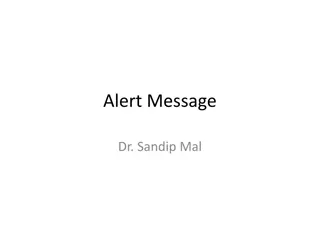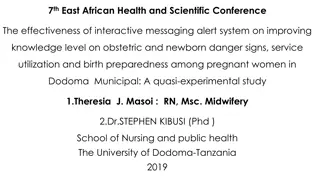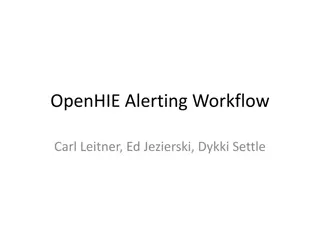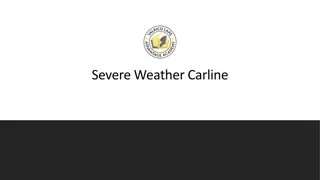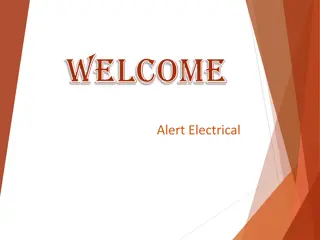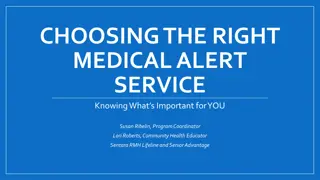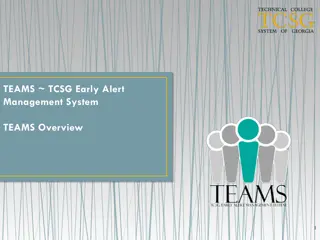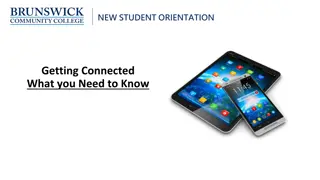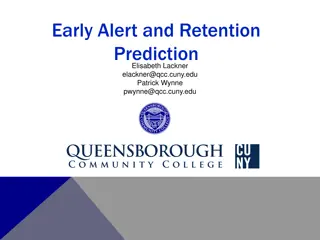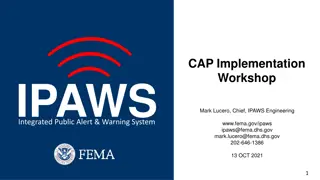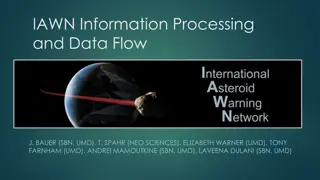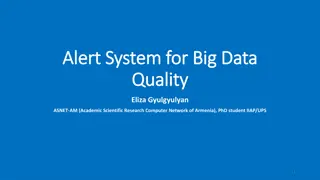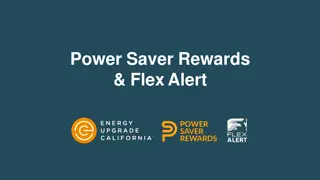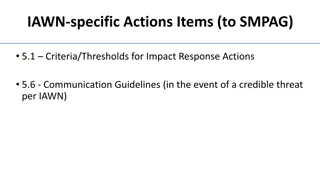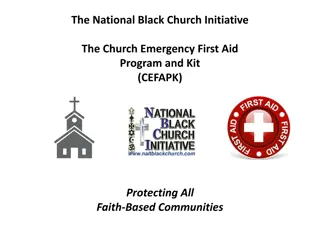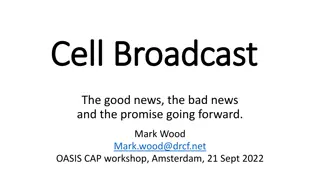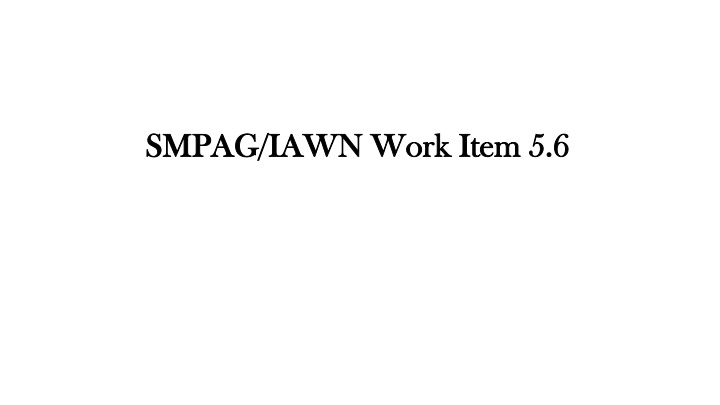
Communication Guidelines for Credible Threat Situations
These communication guidelines outline the necessary steps to be taken by various organizations in the event of a credible asteroid threat, emphasizing clear and concise messaging to the public and government officials. The guidelines include protocols for warning about pending impacts, providing impact location details, and informing relevant entities about the threat.
Download Presentation

Please find below an Image/Link to download the presentation.
The content on the website is provided AS IS for your information and personal use only. It may not be sold, licensed, or shared on other websites without obtaining consent from the author. If you encounter any issues during the download, it is possible that the publisher has removed the file from their server.
You are allowed to download the files provided on this website for personal or commercial use, subject to the condition that they are used lawfully. All files are the property of their respective owners.
The content on the website is provided AS IS for your information and personal use only. It may not be sold, licensed, or shared on other websites without obtaining consent from the author.
E N D
Presentation Transcript
SMPAG/IAWN Work Item 5.6 SMPAG/IAWN Work Item 5.6
SMPAG Work Items 5.1. Criteria and thresholds for impact response actions (NASA) 5.2. Mitigation Mission Types and Technologies to be considered (UKSA) 5.3 Mapping of threat scenarios to mission types (ESA) 5.4. Reference missions for different NEO threat scenarios (ASI) 5.5 A plan for action in case of a credible threat (NASA/IAA) 5.6 Communication guidelines in case of a credible threat (NASA) 5.7 Roadmap for future work on planetary defense (DLR)
5.6 COMMUNICATION GUIDELINES IN CASE OF A CREDIBLE THREAT Lead (NASA with support by IAWN, UNOOSA, ESA, all) Rationale For potential asteroid impact hazards it is essential that communications be clear, correct, consistent, and concise. The development of communication guidelines will help provide a template that IAWN and SMPAG can quickly reference. The guidelines are intended for use by members of SMPAG on the nature of, and methods for, communicating to the public and governmental decision makers. Notifications, Alerts, Alert Levels Internal to NASA, we ve had several discussions on alerts and alert levels to include all items (i.e., from close approach events up through a [larger] impact prediction itself) as alerts starting with Alert Level 1 (close approach). We have tentatively agreed to consider the first so-called levels to be classified as Notifications. We suggest there be only one type of Notification: - Close approaches (i.e., within the geosynchronous belt of satellites)
Communication Guidelines (in the event of a credible threat per IAWN) IAWN/SMPAG: 5.6 If an object 10-meters or greater in size has a 1% or greater probability of impact, IAWN shall warn of the pending impact on the IAWN webpage (http://www.iawn.net ) and JPL sentry page (http://neo.jpl.nasa.gov/risks ). A one page description suffices. If such an object is on impact trajectory, NASA s Center For NEO Studies (CNEOS) and ESA s Near-Earth Object Dynamic Site (NEODyS) shall independently prepare appropriately relevant maps of the Earth impact sites with time of impact. Content of the page: Designation Facts (discovery, size estimate, composition) Impact location (example next pages) IAWN spokesman informs UNOOSA UNOOSA informs appropriate entities and member states of the credible threat
Example Notification Sheet: Close Approach (NASA) Small Asteroid to Pass Close to the Earth on 1-2 Dec 2018 2018 WV1 was discovered by the Catalina Sky Survey, a project based at the University of Arizona in Tucson. This new object is very small, and even though it will approach very close to Earth, it will still not be bright enough to be visible in the small amateur telescopes. At this small size, even if 2018 WV1 had hit Earth, our planet s atmosphere would likely have broken it up and created only a bright meteor and perhaps a few small meteorites. A very small asteroid discovered on 29 November is on a path which will bring it very close to Earth on the evening of 1 Dec. but, there is no chance that the asteroid could impact our planet. ~3 meters (15 feet) in size, the object is predicted to pass within the so-called geosynchronous orbit of communications and weather satellites, about 36,000 kilometers above the equator. The asteroid, designated by the Minor Planet Center as 2018 WV1, will pass about 8300 km inside the orbit of the geosynchronous satellites about half an hour before it reaches its closest point to Earth, which will occur on 2 Dec at 3:10 UTC, at slightly less than 27,000 km above the Earth s surface. After that, the asteroid will head back out into a new orbit about the Sun, as this close pass by Earth will greatly change its previous orbital path. (See URL for graphic: https://cneos.jpl.nasa.gov/news/news202.html)
Discussion Discussion Should the IAWN notification be something more than what it currently is (i.e., brief mention and, in this case seemingly buried)? Judgment call Should it be more journalistic? Other considerations
Level 1 Alert ( 1% probability of impact) Level 1 alert: identification of a 1% or greater probability of impact Provide: Asteroid name/designation Asteroid characteristics size (metric and standard), brightness, etc. Discovery details (observatory, follow-up, characteristics [if known], next observations) (current) Predicted orbit Next observations Expected date of next impact risk update Names and contact information for spokespeople or URLs for more information from responsible orgs IAWN has notified the Space Mission Planning Advisory Group (SMPAG), the international organization responsible for preparing a global response to a possible asteroid impact IAWN and SMPAG are endorsed by the United Nations and coordinate their activities with the United Nations Office of Outer Space Affairs (unoosa.org) in Vienna, Austria.
Example Alert Level 1 Message A small asteroid, provisionally designated 2017 XYZ) was discovered on 31 Nov 2017 by Pan-STARRS located atop Halekakala (Maui), Hawaii and reported to the Minor Planet Center. Additional follow-up observations by the Catalina Sky Survey, the University of Hawaii 2.2-meter, and the Large Altazimuth Telescope (BTA-6) 6-meter telescopes have confirmed the orbit of 2017 XYZ. example Based on current calculations, the asteroid has a 1% probability of impact predicted to occur on 31 Sep 2028 in the Eastern Pacific Ocean near the northern coast of Mexico between 13:05 and 18:30 UTC. Basic facts RE: discovery, follow-up, etc. 2017 XYZ is observed to be approximately 120 meters in size. Current predicted details example Next Observations example Future observations are planned with the planetary radar systems located in Goldstone and Arecibo on 1 April 2018. Further radar observations will precisely determine the orbit of 2017 XYZ. IAWN & SMPAG (trusted sources of information, etc.) The International Asteroid Warning Network (IAWN) has informed the Space Mission Planning Advisory Group (SMPAG), currently chaired by the European Space Agency.
NEO Alert Process Survey, Detect, & Report Publish/ Update Results Correlate, Determine Rough Orbit Observations and Update Orbit Radar Planetary Defense Officer (NASA) Possible New PHO? No Resolve Result Differences Publish Results Iterate Routine Processing Publish Results Yes Yes Alerts to PDCO MPC - PHO of interest MPC -possible close approach CNEOS - reports potential for impact CNEOS -publishes probability of impact No Impact Still Possible? Potential Impact? No Precision Orbit and Follow Up Observations Yes Survey Systems Minor Planet Center Ctr NEO Studies @ JPL * * In parallel with NEODyS
NEO Alert Process Planetary Defense Officer (NASA) IAWN SMPAG supported by ESA (NEODyS) NASA (CNEOS) SMPAG members convene to formulate recommendations Notional SMPAG recommendations briefed to member states Notional Notional UN SMPAG member agencies vet, and agree to, recommendations UN announcement (UNCOPUOS, UNOOSA) Member states inform UN of recommended actions to be taken Member states agree to support SMPAG recommendations YES Action NO
Discussion Discussion Should the IAWN have unique stationery/watermark/heading? Who (what orgs) should be listed as POCs? How is this convened and decision made to announce a Level 1 alert? . . .
Level 2 Alert ( > 10% probability of impact) Level 2 alert: identification of a 10% or greater probability of impact Provide: Asteroid name/designation Date of original notification (i.e., on xx/yy/zz date IAWN issued a Level 1 alert with a 1% probability) (updated) Asteroid characteristics size (metric and standard), brightness, etc. (updated) Details (observatory(ies), follow-up, characteristics [if known], next observations) (updated) Predicted orbit and impact predictions Members of the international Space Mission Planning Advisory Group (SMPAG) are proceeding with a plan to develop a mission to deflect (asteroid designation) off its orbital path, should observers determine that impact is certain, the deflection mission will be ready to launch - OR -
Level 2 Impact Alert (cont) ( > 10% probability of impact) Provide (con t): Based on follow-up observations of the asteroid since then, experts now predict that the asteroid will impact Earth on day/month/year. The international Space Mission Planning Advisory Group (SMPAG) has determined that this impact can be prevented by launching a mission to deflect the asteroid off its orbital path, so that it passes by Earth on day/month/year. The (name the space agency or agencies that will be building and launching the deflection mission) will build a spacecraft (or multiple spacecraft) that will be launched on day/month/year. (Will there be a reconnaissance mission before the deflection mission?) This spacecraft will arrive at the asteroid in month/year and will use the (identify deflection method) method (has the method been demonstrated?) to deflect the asteroid off its impact course with Earth. - OR - Expected date of next impact risk update Names and contact information for spokespeople or URLs for those responsible more info IAWN has notified the Space Mission Planning Advisory Group (SMPAG), the international organization responsible for preparing a global response to a possible asteroid impact IAWN and SMPAG are endorsed by the United Nations and coordinate their activities with the United Nations Office of Outer Space Affairs (unoosa.org) in Vienna, Austria.
Discussion Discussion Additional individuals or orgs listed as POCs? How is this convened and decision made to announce a Level 2 alert? . . .
Example Alert Level 2 Message Basic facts RE: discovery, follow-up, etc.; original IAWN msg A small asteroid, provisionally designated 2017 XYZ was discovered on 31 Nov 2017 by Pan-STARRS located atop Halekakala (Maui), Hawaii. The International Asteroid Warning Network (IAWN) initiated the original message on 2017 XYZ on 2 Dec 2017. New observations of 2017 XYZ is observed to be approximately 120 meters in size. Based on current calculations, the asteroid has a 11% probability (slightly greater than 1-in-10 chance) of impact will be on 31 Sep 2028 in the Eastern Pacific Ocean near the northern coast of Mexico between 12:10 and 13:13 UTC. Radar observations from both Goldstone and Arecibo seem to show 2017 XYZ as a rocky rubble pile asteroid. Example New/updated predicted details The Space Mission Planning Advisory Group (SMPAG) are proceeding with a plan to develop a mission to deflect asteroid 2017 XYZ off its orbital path, should observers determine that impact is certain. The deflection mission will be ready to launch not later than 1 Dec 2023. SMPAG notified Future observations are planned with both the planetary radar systems located in Goldstone and Arecibo as well as other ground-based optical telescopes on 3 March 2021. Further radar observations will precisely determine the orbit of 2017 XYZ. Next Observations IAWN & SMPAG The IAWN has informed SMPAG, currently chaired by the European Space Agency.
Level 3 Impact Alert (Preparation for Impact) IAWN would issue this in coordination with emergency management agencies more discussion To be utilized when deflection is not an option and/or the deflection campaign failed, and when a mitigation civil defense plan is in place. IAWN Provides: Date, time and location of impact Asteroid name/designation Asteroid characteristics size (metric and standard), type (spectral), structural (solid, rubble pile, other) Predicted asteroid trajectory/angle of entry Type of impact atmospheric impact over water or over land, surface impact on water or on land Predicted energy release Geographic range and gradation of effects Impact mitigation measures in place (evacuation, shutdowns, etc.) Civil Defense measure (i.e., tell people what they can/should do) Authoritative source(s) for more information (who s in charge of what)
Example Alert Level 3 Impact Message A small asteroid, provisionally designated 2017 XYZ) was discovered on 31 Nov 2017 by Pan-STARRS located atop Halekakala (Maui), Hawaii. The International Asteroid Warning Network (IAWN) initiated the original message on 2017 XYZ on 2 Dec 2017. Basic facts example was subsequently struck by the NASA DART-2 mission. This later impact created multiple 10-20 meter sized fragments that are now inbound in the northern Pacific Ocean, ~200 kilometers south of the Aleutian Island archipelago. Two kinetic impactor missions were launched in February 2020 in an effort to alter the trajectory of 2017 XYZ. The JAXA mission Tenjin impacted the asteroid on 3 March 2024, splitting into two fragments. One fragment was ~30 meters and the remaining 90-meter fragment New/updated predicted details example example (unoosa.org) in Vienna, Austria. The IAWN has also informed UNOOSA. Discussion of expected effects (fireball, flash, damage to infrastructure) _ Based on current calculations, the first of the 2017 XYZ fragments will impact the Earth s atmosphere beginning at 12:21 UTC at 48 North latitude, 170 West longitude extending almost due eastward to 166 West longitude. The impacts should pose no hazard to cities and will appear as a series of Chelyabinsk-like bolides across the sky, impacting harmlessly into the northern Pacific Ocean. IAWN and SMPAG are endorsed by the United Nations and coordinate their activities with the United Nations Office of Outer Space Affairs IAWN & SMPAG
Discussion Discussion Additional individuals or orgs listed as POCs? How is this convened and decision made to announce a Level 3 alert? In this scenario example, deliberately made it harmless. Should we consider drafting more serious/significant scenarios?


